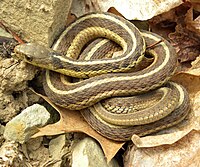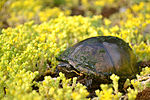
Thirty species of reptiles have been recorded in the US state of Minnesota, including 16 species of snakes, eleven species of turtle, and three species of lizard. [1] Of those 31 species, two (Blanding's turtle and the wood turtle) have been listed as endangered by the International Union for Conservation of Nature, with another 20 listed as least concern and nine have not been evaluated.
Contents
Minnesota does not have an official state reptile. However, the Blanding's turtle was proposed as the reptile of the state in 1998 and 1999. [2]





























